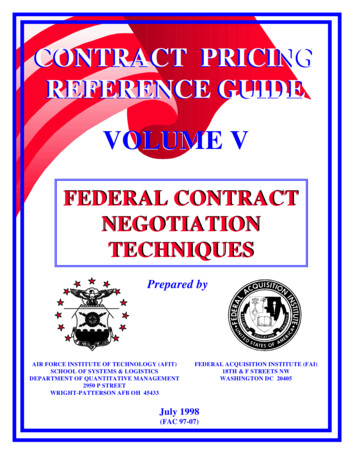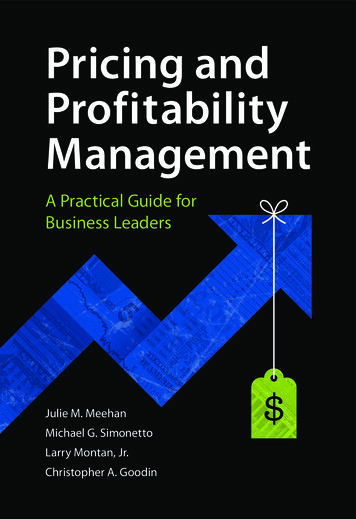
Transcription
CONTRACT PRICINGREFERENCE GUIDEVOLUME VFEDERAL CONTRACTNEGOTIATIONTECHNIQUESPrepared bybyPreparedAIR FORCE INSTITUTE OF TECHNOLOGY (AFIT)SCHOOL OF SYSTEMS & LOGISTICSDEPARTMENT OF QUANTITATIVE MANAGEMENT2950 P STREETWRIGHT-PATTERSON AFB OH 45433FEDERAL ACQUISITION INSTITUTE (FAI)18TH & F STREETS NWWASHINGTON DC 20405July 1998(FAC 97-07)
ACKNOWLEDGMENTSThis July 1998 version of Federal Contract Negotiation Techniques is Volume V of the five (5) volumeContract Specialist Reference Guides prepared pursuant to FAR 15.404-1(a)(7) by the:Federal Acquisition InstituteWashington, DCandAir Force Institute of TechnologyDepartment of Contracting ManagementWright-Patterson AFB, OHMichael MillerDirectorRalph LiebhaberInstructor (CON 104)Jeritta ParnellProgram ManagerAlan J. BoykinCourse Director (CON 104)revised under contract with:M. Dale Shields, Ph.D.DAYPRO AssociatesDayton, OHThe following are acknowledged for their technical and managerialcontributions to preparing this reference guide:Mr. Gary T. AllenDefense Logistics AgencyCivilian PersonnelSupport OfficeMr. Gary FidlerDefense Logistics AgencyCivilian Personnel Support OfficeMs. Joyce AllenOffice of Assistant Secretary (Acquisition)United States Air ForceMr. Jerry C. GilbartContracting DirectorateDefense Logistics AgencyMr. Bob BembenOffice of Assistant Secretary (Acquisition)United States Air ForceLt. Col. Jaureguy L. JaggersAir Force Institute of TechnologyMs. Donnette CapelloDepartment of EnergyMr. Richard E. Chittenden (Retired)Naval Facilities Contracts Training CenterMr. Patrick ConleyFederal Supply ServiceGeneral Services AdministrationLt. Christopher J. Luz, CEC, USNNaval Facilities Contracts Training CenterMs. Julie KrucDefense National Stockpile CenterMr. James MurphyDepartment of CommerceMs. Kim NovakInternal Revenue ServiceMr. Jeremy F. OlsonGeneral Services AdministrationOffice of Acquisition PolicyMr. William H. RocheTank Automotive and Armament CommandMr. David SchuurNaval Supply Systems CommandMr. William G. Smith, IIAeronautical Systems CenterMs. Rose Mary SwindellNaval Center for Acquisition TrainingMs. Faye TurnerDefense Contract Management CommandWe also acknowledge all course directors, instructors, and field experts whohave made tremendous contributions to this course of instruction since itsinception over 35 years ago.A very special thanks is extended to Ms. Melinda D. Nelms for her invaluableadministrative and technical support in the completion of this guide.
PREFACEFederal Contract Negotiation Techniques (Volume V)P-1
PrefaceCONTRACT PRICING REFERENCE GUIDESThe Air Force Institute of Technology and the Federal Acquisition Institute have jointlyprepared a series of contract pricing reference guides for pricing and contract personnel.These guides, listed below, are referenced in FAR 15.404-1(a)(7).Volume I - Price AnalysisVolume II - Quantitative Techniques for Contract Pricing & Glossary of TermsVolume III - Cost AnalysisVolume IV - Advanced Issues in Contract PricingVolume V - Federal Contract Negotiation TechniquesThe five volumes are part of a curriculum of courses used to help contracting personnelbecome proficient in the performance of the duties and tasks associated with theirparticular jobs.P-2Federal Contract Negotiation Techniques (Volume V)
PrefaceUSING THIS CONTRACT PRICING REFERENCE GUIDEThis text/reference was developed for use at your job site as well as in the classroom. Itsstep by step approach, FAR references, structured writing and index are all designed forthe easy and quick retrieval of information about the contracting process. It is “dated” byindicating that is current through a specific Federal Acquisition Circular (FAC). This letsyou know exactly how up to date it is. You may obtain updates from the FAI InternetHomepage at http://www.gsa.gov/fai or annotate your own copy as FAR policies change.Federal Contract Negotiation Techniques (Volume V)P-3
PrefacePURPOSE OF THIS CURRICULUMTo Help YouAccomplish TheGoals Of TheFederalAcquisitionProcessAs a Contract Specialist, your primary goals are to:1. Obtain the optimum market response to requirements for supplies andservices, in terms of: Quality, Timeliness, andPrice;While Accomplishing socioeconomic objectives, Minimizing business and technical risks, Maximizing competition, and Maintaining integrity.2. Assure that purchased supplies and services are: Delivered or performed when and where specified in the contract. Acceptable, in terms of the contract requirements documents. Provided in compliance with other terms and conditions of thecontract.To Help YouPerform YourDutiesTo accomplish these goals, Contract Specialists must be able to perform85 principal duties. Collectively, these duties constitute the Federalacquisition process. Exhibit P-1 maps the acquisition process and relateseach duty to the overall process. This curriculum has been designed tosystematically develop your skill at every duty in Exhibit P-1, in thecontext of accomplishing the overall goals of the Federal AcquisitionProcess.Your ChallengeYour challenge is to become proficient in performing the duties describedin Exhibit P-1. Granted, you may presently perform only a subset of theduties. In terms of your career, however, learning the entire range ofduties will improve your competitiveness for a great variety of contractingpositions, including managerial positions. From the standpoint of theGovernment, you will be better able to perform any assigned duty if youhave firsthand knowledge of how each duty relates to the performance ofthe other duties.P-4Federal Contract Negotiation Techniques (Volume V)
PrefaceI. ACQUISITION PLANNINGSTEPSA.DETERMINATIONOF NEEDB. ANALYSISOFREQUIREMENTC. EXTENT OFCOMPETITIOND. SOURCESELECTIONPLANNINGE.SOLICITATIONTERMS ANDCONDITIONSRelated Functions1. ForecastingRequirements7. RequirementsDocuments10. Sources2. AcquisitionPlanning8. Use of Gov'tProperty and SupplySources11. Set Asides3. PurchaseRequests9. Services4. Funding12. 8(a)Procurements13. CompetitionRequirements &Unsolicited14. Lease vsPurchase15. Price-RelatedFactors16. Non-PriceEvaluation Factors17. Method ofProcurement5. RecurringRequirements18. Contract Types- PricingArrangements19. UnpricedContracts20. ContractFinancing21. Need forBonds22. Method ofPayment6. MarketResearch/EarlyExchanges23. ProcurementPlanning0. ORIENTATION: ACQUISITION SYSTEM VALUES, GOALS, &STANDARDSExhibit P-1Federal Contract Negotiation Techniques (Volume V)P-5
PrefaceII. CONTRACT FORMATIONSTEPSF. SOLICITATION OFOFFERSG. BIDEVALUATIONH. PROPOSALEVALUATION &NEGOTIATIONI. CONTRACTAWARDRelated Functions24. Publicizing ProposedProcurements30. Processing Bids25. Oral Solicitation31. Bid AcceptancePeriods26. SolicitationPreparation32. Late Offers27. Preaward Inquiries28. Prebid/Prequote/Preproposal Conferences29. Amending/CancelingSolicitations35. Processing Proposals36. Applying Non-PriceFactors37. Price Analysis33. Bid Prices34. Responsiveness38. Pricing InformationFrom Offerors39. Audits40. Cost Analysis41. Evaluating OtherOffered Terms &Conditions47. Mistakes in Offers48. Responsibility49. SubcontractingRequirements50. Prepare Awards51. Issue Awards andNotices52. Debriefing53. Protests42. Award WithoutDiscussions43. Communications/Factfinding44. Competitive Range45. Negotiation Strategy46. ConductingNegotiationsExhibit P-1 (cont)P-6Federal Contract Negotiation Techniques (Volume V)
PrefaceIII. CONTRACT ADMINISTRATIONSTEPSJ. INITIATION OFWORKK. QUALITYASSURANCEL. PAYMENT ANDACCOUNTINGM. MODIFICATION& SPECIAL TERMSN. CONTRACTCLOSEOUT ORTERMINATIONRelated Functions54. ContractAdministrationPlanning56. Monitoring,Acceptance andInspection55. Post-AwardOrientations57. Delays76. ContractModifications82. Claims66. Assignment ofClaims77. Options83. Closeout58. Stop Work67. AdministeringFinancing Terms78. PropertyAdministration84. Termination59. CommercialRemedies68. UnallowableCosts79. IntellectualProperty85. Fraud &Exclusion69. Payment ofIndirect Costs80. AdministeringSocio-Economic &Other Misc. Terms61. DocumentingPast Performance70. Limitation ofCosts81. Task &Delivery OrderContracting62. Consent toSubcontracts71. Price and FeeAdjustments63. SubcontractingRequirements72. CollectingContractor Debts64. AdministeringSecurities73. Accounting &Estimating Systems60. NoncommercialRemedies65. Invoices74. Cost AccountingStandards75. DefectivePricingExhibit P-1 (cont)Federal Contract Negotiation Techniques (Volume V)P-7
PrefaceOVERVIEW OF FEDERAL CONTRACT NEGOTIATION TECHNIQUES(VOLUME V)The following are among the primary duties from Exhibit P-1 covered in this text/reference:Unit t-Finding245Negotiation Strategy346Conducting Discussions/Negotiations4-8Federal Contract Negotiation Techniques (Volume V)
FEDERAL CONTRACTNEGOTIATION TECHNIQUESCONTENTSCHAPTER 1 Introduction To Negotiations1.0Chapter Introduction .1-31.1Describing Negotiations.1-41.2Recognizing Possible Negotiation Outcomes And Styles.1-111.3Describing Attitudes That Lead ToSuccessful Negotiation Themes .1-19CHAPTER 2 Exchanges Prior To Negotiations2.0Chapter Introduction .2-32.1Identifying Contractor InformationNeeded For Proposal Analysis .2-52.2Selecting Methods For Conducting An Exchange .2-102.3Selecting And Preparing Participants For Face-To-Face Exchanges.2-12Federal Contract Negotiation Techniques (Volume V)i
Table of Contents2.4Conducting Face-To-Face Exchanges.2-182.5Using Exchange Results.2-23CHAPTER 3 Negotiation Preparation3.0Chapter Introduction .3-33.1Tailoring The Negotiation Team To The Situation.3-73.2Identifying Negotiation Issues And Objectives .3-103.3Identifying The Contractor's Probable Approach To Negotiation .3-143.4Assessing Bargaining Strengths And Weaknesses.3-173.5Identifying Negotiation Priorities And Potential Tradeoffs.3-213.6Determining An Overall Negotiation Approach .3-253.7Preparing A Negotiation Plan .3-273.8Presenting A Negotiation Plan To Management.3-303.9Preparing A Negotiation Agenda .3-32CHAPTER 4 Noncompetitive Negotiations4.0Chapter Introduction .4-34.1Recognizing The Steps Of Negotiation.4-54.2Recognizing Differences Between Pre- AndPost-Award Negotiations .4-154.2.14.2.24.3iiRecognizing Special Considerations ForEquitable Adjustments .4-16Recognizing Special Considerations ForTermination Settlements .4-21Identifying Documentation Requirements .4-25Federal Contract Negotiation Techniques (Volume V)
Table of ContentsCHAPTER 5 Nonverbal Communication5.0Chapter Introduction .5-35.1Recognizing Different Forms Of Nonverbal Communication .5-45.2Describing How Body Language Affects Negotiations .5-85.3Describing How The Physical Environment Affects Negotiations.5-135.4Recognizing How Personal Attributes Affects Negotiations .5-18CHAPTER 6 Bargaining Techniques6.0Chapter Introduction .6-36.1Rule 1: Be Prepared.6-46.2Rule 2: Aim High .6-66.3Rule 3: Give Yourself Room To Compromise.6-96.4Rule 4: Put Pressure On The Contractor .6-126.5Rule 5: Do Not Volunteer Weaknesses.6-146.6Rule 6: Use Concessions Wisely.6-166.7Rule 7: Say It Right.6-186.8Rule 8: Satisfy Non-Price Issues.6-206.9Rule 9: Use The Power Of Patience.6-216.10Rule 10: Be Willing To Walk Away From Or Back To Negotiations.6-22CHAPTER 7 Bargaining Tactics7.0Chapter Introduction .7-37.1Using Win/Win Tactics.7-4Federal Contract Negotiation Techniques (Volume V)iii
Table of Contents7.2Identifying Win/Lose Tactics And Appropriate Countermeasures.7-10CHAPTER 8 Conducting Discussions8.0Chapter Introduction .8-38.1Recognizing The Steps For Competitive Discussions .8-58.2Conducting A Comparative Assessment of Final Proposals.8-108.3Communicating Assessment Results .8-138.4Identifying Documentation Requirements .8-16FAR Index.FAR-1ivFederal Contract Negotiation Techniques (Volume V)
CHAPTER 1Introduction toNegotiationsFederal Contract Negotiation Techniques (Volume V)1-1
Introduction to NegotiationsChapter ObjectivesAt the End ofThis ChapterAt the end of this chapter you will be able to:Chapter Objective 1/1Describe negotiations.Chapter Objective 1/2Recognize the three possible negotiation outcomes and negotiationstyles.Chapter Objective 1/3Describe negotiator attitudes that lead to successful negotiations.1-2Federal Contract Negotiation Techniques (Volume V)
Introduction to Negotiations1.0 Chapter IntroductionIn This ChapterIn this chapter you will learn about the basics of negotiation.SECTIONDESCRIPTIONSEEPAGE1.0Chapter Introduction1-31.1Describing Negotiations1-41.2Recognizing Possible NegotiationOutcomes And Styles1-111.3Describing Attitudes That Lead ToSuccessful Negotiations1-19Federal Contract Negotiation Techniques (Volume V)1-3
Introduction to Negotiations1.1 Describing NegotiationsNegotiation IsPart of LifeNegotiation is a part of normal everyday life. In fact, experts on thesubject have said that life, itself, is just one continuous negotiation.FAR 15.402Still, many people feel that they are not experienced contractnegotiators. Perhaps they do not realize that there are many types ofcontracts. Not all are complex written agreements. Most contracts areoral agreements which may or may not involve the exchange ofmonetary consideration.Without realizing it, you have probably been involved in a variety ofcontract negotiations every day of your life. In fact, we constantlybargain with other people to fulfill both our monetary and nonmonetary needs. At work, you are probably involved in continuing negotiationswith your superiors, subordinates, and coworkers concerning avariety of personal and professional issues. They may be asminor as deciding who will make the next pot of coffee or asmajor as the rating on your annual performance evaluation. At home, you are probably involved in continuing negotiationswith your family over a wide variety of issues. They may be asminor as the time for dinner or as major as where you will live.A child crying for a favorite toy can be a formidable negotiator. You have likely been involved in numerous negotiations thatwill have a long-term affect on the course of your life,including: The terms of your current employment; An automobile purchase contract or lease agreement; or Your home mortgage or apartment rental agreement.In fact, you must negotiate for most things you want in life. You canonly avoid negotiation if you have no desire for anything held orcontrolled by someone else. Regardless of your profession, skill as anegotiator is essential to your success. In Government contracting, theskill is particularly important because your daily work requires you toobtain supplies and services from responsible sources at fair andreasonable prices.1-4Federal Contract Negotiation Techniques (Volume V)
Introduction to Negotiations1.1 Describing Negotiations (cont)Description ofNegotiationNegotiation is a process of communication by which two parties, eachwith its own viewpoint and objectives, attempt to reach a mutuallysatisfactory result on a matter of common concern.In negotiation, a mutually satisfactory result is vital, because eventhough the parties may have opposing interests they also are dependenton each other. Labor and management, for example, need each other toproduce products efficiently and effectively. Likewise, buyers andsellers need each other to transact business. Both sides must be willingto live with the result.Negotiation is not one party dictating or imposing terms on another.When that happens, the outcome will rarely produce mutualsatisfaction. The result can only be mutually satisfactory if bothdifferences and common interests are considered.To obtain agreement, you must generally sacrifice or yield somethingin order to get something in return. In other words, you must give toget. But as long as the anticipated benefit is greater than your sacrifice,a negotiated agreement is beneficial. The limit on yielding is reachedwhen one party believes that concessions would be more costly than thebenefits of agreement.While negotiation is often a process of mutual sacrifice, it should alsobe a process of finding ways whereby both parties will have theirinterests optimized under the circumstances. Negotiations should notjust be aimed at how to split the pie. Instead they should be aimed atfinding optimal solutions -- ways to make the pie larger for allconcerned. For example, both parties benefit when negotiators find thata change in buyer requirements will enable the seller to deliver ahigher-quality standard product instead of a specially built product.The seller realizes lower risks or perhaps more profit from the sale of astandard product. The buyer pays a lower price for a product that meetsthe buyer’s real needs.Federal Contract Negotiation Techniques (Volume V)1-5
Introduction to Negotiations1.1 Describing Negotiations (cont)NegotiatedContracts vs.Sealed BiddingFAR 14.101(d)FAR 15.000FAR 52.215-1GovernmentContractNegotiationsFAR 15.306(d)1-6The Federal Acquisition Regulation (FAR) states that any contractawarded using other than sealed bidding procedures is considered anegotiated contract. Procedures for contracting by sealed bidding require theGovernment to evaluate bids without discussions and award tothe responsible bidder whose bid, conforming to the invitationfor bids, will be most advantageous to the Governmentconsidering only price and price related factors. Negotiationsare not permitted prior to contract award. Procedures for contracting by negotiation permit negotiationsprior to contract award. However, a solicitation underprocedures for contracting by negotiation may or may notactually require negotiations. For example, the Instructions toOfferors -- Competitive Acquisition: Standard provision states that the “Government intends toevaluate proposals and award without discussions.” Whenthat provision is used, actual negotiations are not permittedunless the contracting officer determines in writing that theyare necessary. Alternate I, states that the “Government intends to evaluateproposals and award a contract after conducting discussionswith offerors whose proposals have been determined to bewithin the competitive range.” Here negotiations arerequired with any offeror(s) in the competitive range.In Government contracting:Negotiations are exchanges, in either a competitive or sole sourceenvironment, between the Government and offerors, that areundertaken with the intent of allowing the offeror to revise its proposal.These negotiations may include bargaining. Bargaining includespersuasion, alteration of assumptions and positions, give-and-take, andmay apply to price, schedule, technical requirements, type of contract,or other terms of a proposed contract. When negotiations areconducted in a competitive acquisition, they take place afterestablishment of the competitive range and are called discussions.Federal Contract Negotiation Techniques (Volume V)
Introduction to Negotiations1.1 Describing Negotiations (cont)GovernmentContractNegotiations(cont)The key word in this definition is "bargaining." The Governmentanticipates that bargaining will occur in competitive as well asnoncompetitive negotiations.SatisfactoryNegotiationResultsWhat is a satisfactory result in a Government contract negotiation?That depends on whether the negotiation is competitive ornoncompetitive and when it takes place in the contracting process.FAR 15.101FAR 15.402(a)FAR 43.103(a)FAR 49.201(a) Competitive discussions may take place either before contractaward or before award of a task/delivery order under anindefinite-delivery indefinite-quantity contract. The discussionswith each offeror in the competitive range should be directed tofacilitating preparation of a final proposal revision that willprovide the best value for the Government, given the awardcriteria, the offeror’s proposal, and existing constraints withinthe offeror’s organization. Then the Government can evaluatethe available proposals to determine which proposal offers theoverall best value. Noncompetitive negotiations can take place either before orafter award. In noncompetitive negotiations for: Award of a new contract or a task/delivery order under anexisting indefinite-delivery indefinite-quantity contract, thesatisfactory result is a contract or order that provides for thepurchase of the required supplies or services from aresponsible source at a fair and reasonable price. A bilateral contract modification, the satisfactory result is acontract modification that reflects the agreement of theparties about any modification of contract terms, includingany necessary equitable adjustment related to themodification. A fixed-price termination for convenience settlement, thesatisfactory result is a settlement that fairly compensates thecontractor for the work done and the preparations made forthe terminated portions of the contract, including areasonable allowance for profit.Federal Contract Negotiation Techniques (Volume V)1-7
Introduction to Negotiations1.1 Describing Negotiations (cont)The OtherParty inGovernmentContractNegotiationIn preaward Government contract negotiations, a potential recipient ofthe Government contract is normally referred to as an “offeror.” Inpost-award situations, the contractor may still be considered an offeror,because the negotiation centers on the offer submitted by the contractor.However, most contracting professionals use the term contractor aftercontract award. It would be particularly confusing to refer to a firmsubmitting a contract termination proposal as an offeror.To avoid confusion, this text will consistently use the term “contractor”in referring to the non-Government party in a Government contractnegotiation.NegotiationSuccess1-8A successful negotiation is a product of many factors. Factors thatcontribute to success in any negotiation always include: The specific circumstances surrounding each negotiation.This may be viewed as the bargaining leverage available to eachparty involved. For example, the circumstances often favor thecontractor when the Government is bargaining for a highdemand product in short supply. Similarly, the circumstanceswill generally favor the Government when several firms arevying to provide a product only demanded by the Government. The skill of the negotiators. Highly skilled negotiators willhave a greater probability of negotiation success thannegotiators who do not have the requisite skills. Goodnegotiators can often obtain favorable deals under adversecircumstances. Conversely, negotiators with poor bargainingskills sometimes fail to obtain satisfactory agreements evenwhen the circumstances favor their bargaining position. The motivation and fairness of each party. The greater themotivation and fairness on each party, the more likely it is thatthe negotiations will end with a satisfactory agreement. Successful outcomes are more likely when one or bothparties are willing to make fair concessions. The likelihood of successful negotiation decreases wheneither party is poorly motivated or unfair. Achievingnegotiation success becomes particularly difficult when oneparty is unwilling to compromise or show any flexibility.Federal Contract Negotiation Techniques (Volume V)
Introduction to Negotiations1.1 Describing Negotiations (cont)NegotiatorAbilitiesThe best negotiators exhibit the ability to: Plan carefully. Planning begins with requirement developmentand continues through negotiation. It includes market research,solicitation preparation, and proposal evaluation. You mustknow the product, the rules of negotiation, and youralternatives. Gain management support. Management support is vital toyour success as a negotiator. If contractor personnel know thatmanagement does not support your objectives, the contractor’snegotiators may simply tolerate you until they can escalate thenegotiation to management. Effectively apply bargaining techniques. Good negotiatorsare capable of employing bargaining techniques which facilitatenegotiation success. Communicate effectively. Good negotiators: Sell others on their bargaining position by speaking in anarticulate, confident, and businesslike manner. Disagree with others in a cordial and non-argumentativemanner. Listen effectively. Many otherwise good negotiators beginto concentrate on their answer almost as soon as the otherparty begins speaking. As a result, they miss the truemeaning of the communication. Tolerate conflict while searching for agreement. Mostcontract negotiations involve some conflict. After all, no twopeople on earth agree on everything all the time. Negotiatorswho: Can agree to disagree in a polite and respectful manner willbe able to search for ways to achieve a mutually satisfactoryoutcome. Will give anything to avoid conflict are often not able tosecure satisfactory results for their side. Who display a tendency for arguing will increase theconflict and make a satisfactory outcome all the moredifficult to attain.Federal Contract Negotiation Techniques (Volume V)1-9
Introduction to Negotiations1.1 Describing Negotiations (cont)NegotiatorAbilities (cont)1-10 Project honesty. Good negotiators are honest and they makeothers believe that they are honest. Securing trust is vital tosecuring a mutually satisfactory outcome. Concessions aredifficult to obtain when other do not trust you. Foster team cooperation. All members of the negotiation teammay not agree on every issue. Disagreements must be resolvedin a manner that fosters team cooperation and the appearance ofteam unity during contract negotiations. Apply good business judgment. Good negotiators are able toevaluate every change in a negotiating position based on itsoverall effect on attaining a mutually satisfactory result.Federal Contract Negotiation Techniques (Volume V)
Introduction to Negotiations1.2 Recognizing Possible Negotiation Outcomes And StylesNegotiationOutcomesIn general, there are three possible outcomes to every negotiation.These outcomes are known as “win/win,” “win/lose,” and “lose/lose.”Any negotiation can conceivably result in any of these outcomes, butdifferent negotiation styles can make one or the another more likely.Win/WinOutcomesA win/win outcome (also known as a both-win outcome) occurs whenboth sides achieve long-term satisfaction with negotiation results.Negotiations emphasize developing a mutually beneficial agreement.For example, awarding a contract at a fair and reasonable price is in thebest interest of both the contractor and the Government.FAR 15.101FAR 15.402(a)FAR 43.103(a)FAR 49.201(a)Commercial businesses are emphasizing win/win negotiations becauseof the increasing importance of long-term business relationships. Eachside has a vested interest in mutual long-term satisfaction. Any shortterm advantage achieved by wringing out every last con
Volume I - Price Analysis Volume II - Quantitative Techniques for Contract Pricing & Glossary of Terms Volume III - Cost Analysis Volume IV - Advanced Issues in Contract Pricing . Applying Non-Price Factors 37. Price Analysis 38. Pricing Information From Offerors 47. Mistakes in Offers 48. Responsibility 49. Subcontracting Requirements 50 .










